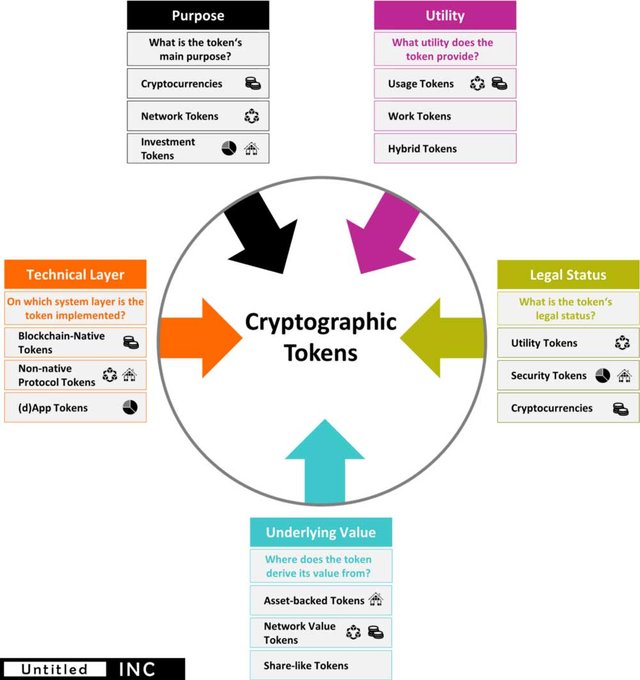5 ways to classify Cryptocurrency
As the latest block chain technology became widely known and published, hundreds of cryptocurrency were created. In a block-chain ecosystem, cryptocurrency serves as a means of delivering monetary value.
Basically it is the means by which the concept of the Distributed Ledger is made possible technically, and from the viewpoint of the block-chain business, it also serves as an economic key to driving specific activities of internal ecosystem participants.
The block chain technology is the core technology of the 4th industrial revolution, in which a lot of capital and talent are invested. So we need to think about and understand the various aspects of cryptocurrency that is based on block-chain technology.
In recent, FINMA in Switzerland and the SEC in the United States have attempting to differentiate the type of cryptocurrency according to whether the cryptocurrency has a securities nature and to incorporate it into existing financial laws.
What are the criteria for categorizing cryptocurrency? Let’s look at classification criteria from various perspectives.
1. Dictionary definition of coins and tokens
cryptocurrency is called ‘coin’ or ‘token’.
The dictionary definition of a coin is “A flat, typically a piece of metal with an official stamp, used as money”. In other words, it is a means that can be used instead of the existing legal currency.
On the other hand, the dictionary definition of the token is “A voucher that can be exchanged for goods or services.” In other words, it has the meaning as a voucher that can be exchanged for goods or services.
For coins, coins and tokens are determined by the presence of “main net”. That is, if you own your own block-chain protocol “mainnet” and configure an independent ecosystem that does not depend on other platforms, you can say “coin”.
Typical “coins” include bit coin, ethereum, and ripple.
Tokens are cryptocurrency that are issued without own “main net”. For example, a token is a cipher that is issued in the form of dapp above a protocol like Ethereum.
However, even if it is issued as a token, developing your own “main net” can turn into a coin. EOS uses Ethereum’s protocol but now says it will launch its own main net called EOS.IO.
Coins and tokens are different from each other, but they are perceived as the same in the real cryptocurrency market. And they are traded freely through the exchange market.
2. Untitled INC’s cryptocurrency Classification Criteria
In fact, there is no recognized classification system for cryptocurrency. However, referring to the classification criteria of ‘Untitled INC’, you can categorize the type of cryptocurrency with the following five views.

untitled-inc
Classification according to main purpose
- Cryptocurrencies: Cryptocurrency for the purpose of ‘digital money’ function for transferring monetary value. ex) BTC(bitcoin)
- Network Tokens: Cryptocurrency money aimed at activation and growth of ecosystem network. ex) GNO(gnosis)
- Investment Tokens: Cryptocurrency for the purpose of real property investment. ex) DGX(digix gold)
Classification by usability
- Usage Tokens: Cryptocurrency functions that give access to network or service functions. ex) BTC(bitcoin), STX(blockstack)
- Work Tokens: Cryptocurrency that allows the owner to make operational contributions to the network system. ex) REP(angur)
- Hybrid Tokens: Cryptocurrency currency when performing both Usage token and Work token functions. ETH(ethereum), DASH(dash)
Classification according to legal status
- Utility Tokens: Cryptocurrency that provides access to or provides discounts or special rights to goods and services of the block-chain ecosystem. ex) STEEM(steem)
- Security Tokens: Also known as Asset Token, it promises to distribute future corporate income or capital flows. Functionally, they are classified as securities in FINMA, similar to stocks or bonds. ex) SPice(spice vc)
- Cryptocurrencies: Also referred to as a payment token, Cryptocurrency designed as a means of payment for the purchase of goods or services or as a means of transferring monetary value. ex) BTC(bitcoin)
Classification by Fundamental Value
- Asset-backed Tokens: Means digital assets that are backed by tangible or intangible assets of economic value, such as real estate and energy. If you are issuing and distributing a Cryptocurrency for the ownership of the artwork. ex) GOLD(goldmint)
- Network Value Tokens: If the value of the Cryptocurrency is linked to the value of the network. ex) ETH(ethereum), STEEM(steem)
- Share-like Tokens: Cryptocurrency that promises future income, distribution of capital, voting rights, etc. Also classified as a security token.
Classification by technology level
- Blockchain-Native Tokens: Block Chain Cryptocurrency that is issued directly at the bottom of the hierarchy, according to the block creation. ex) BTC(bitcoin), ETH(ethereum)
- Non-native Protocol Tokens: Cryptocurrency implemented through a cryptographic protocol. ex) REP(augur)
- App Tokens: Cryptocurrency with functionality close to token implemented in the application layer of the block chain. ex) WIZ(gnosis)
Congratulations @attrest! You have completed the following achievement on Steemit and have been rewarded with new badge(s) :
Click on the badge to view your Board of Honor.
If you no longer want to receive notifications, reply to this comment with the word
STOPTo support your work, I also upvoted your post!
Do not miss the last post from @steemitboard:
SteemitBoard World Cup Contest - The results, the winners and the prizes